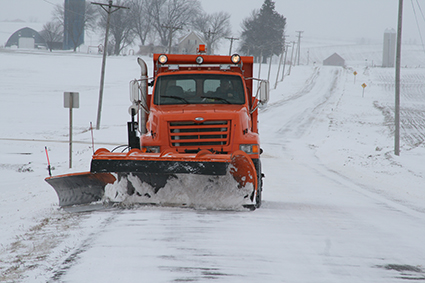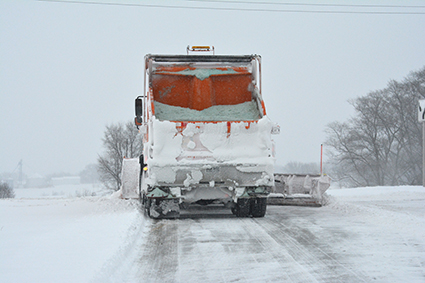Everything you've ever wanted to know about winter road maintenance in Wisconsin:
Roadways
- The Wisconsin DOT contracts with all 72 county highway departments in the state to maintain the state highway system. (Interstates, federal and state numbered highways)
- There are 115,000 miles of local streets and county and state highways in Wisconsin including 11,916 miles or 34,723 lane miles (one lane mile equals a one mile roadway that is 12 feet wide) of state maintained highways.
Weather
- Wisconsin average snowfall ranges from about 40 inches in the south to as much as 200 inches along the shores of Lake Superior.
- On average, about 35 to 40 winter weather events hit Wisconsin each winter.
- Blowing snow and fog that occur periodically can cause severe visibility restrictions for drivers.
- While only a couple large freezing rain events normally strike the state each winter, the state experiences numerous freezing drizzle and freezing fog events that cause roads to ice over.
- Frost on bridge decks and pavements typically occurs in October, November, and March.
Snowplow drivers
- There are over 1,500 county highway department employees that are licensed to operate a snowplow. Approximately 754 of them are permanently assigned to the state maintained highway system.
- All operators on the state system are required to hold a current Commercial Drivers License (CDL).
- When snowplow drivers are not involved in snow and ice operations, they work on priority maintenance projects including equipment maintenance, crack sealing and pothole patching, maintaining clear zones, maintaining drainage systems, emergency shoulder repair, sign maintenance and repair, vegetation management, etc.
Snowplow safety
- Snowplows typically travel at 25-35 mph, which in many cases is significantly slower than the posted speeds. The driver's field of vision is also severely restricted.
- It is illegal (s.346.915, Wis. Stats.) to follow a snowplow closer than 200 feet upon any highway having a posted speed limit of more than 35 mph if the snowplow is engaged in snow and ice removal.
- It is legal to pass a snowplow but care should be taken when attempting this maneuver because it's often difficult to see past the snowplow because of the snow cloud. Also the snowplow's wing blade can extend up to 10 feet beyond the width of the truck. Many snowplow wing blades are hit each season by vehicles attempting to pass the snowplow.
- Between 1984-2004 there were 17 snowplows involved in fatal crashes in Wisconsin. (Snowplow crash information has not been gathered since 2004.)
Snow removal
- WisDOT's snow removal program divides the state maintained highways into 5 categories based on the highway's traffic volumes, use, and configuration. The goal for each category of roadway is to achieve "passable roadways" during a winter storm.
- Passable roadways are defined as roadways that are free of drifts, snow ridges, and as much ice and snow pack as is practical and can be traveled at reasonable speeds. A reasonable speed is one in which a vehicle can travel without losing traction.
- Category 1 highways receive more attention and resources than other highway categories thus it will take less time to achieve bare/wet pavement and ultimately bare/dry pavement on these highways. Category 1 highways are multi-lane highways that typically carry more than 75,000 vehicles per day, while category 5 highways are rural two-lane highways that have less than 5,000 vehicles per day.
- Snow removal times can vary depending on moisture content of the snow and weather conditions. Heavy, wet snow followed by a cold snap could require more time to clear than dry snow.
- The county highway departments who maintain the state highway system are not liable for injuries caused by ice or snow accumulation on the roadway unless it has been there for more than 3 weeks (s. 81.15, Wis. Stats.). That being stated, it typically takes only a day or two, even in the worst storms, to remove the majority of the ice and snow from the pavement.
Snow removal techniques
- For the winter of 2021-22, 66 of the 72 counties in Wisconsin used a technique called anti-icing, which can save time and money by reducing the effort and materials needed to remove snow and ice.
- Anti-icing prevents the formation of frost and the bonding of snow and ice to the pavement, which makes it easier for the plow to remove mechanically.
- Anti-icing agents, which are primarily liquids, are applied before or early in a snow storm.
- Other removal techniques include pre-wetting and de-icing.
- Pre-wetting is the addition of calcium chloride, magnesium chloride, salt brine or other liquid agents to salt and sand. This helps the mixture stick to the road instead of blowing off to the shoulder, which reduces the amount of material needed. It also helps the salt start working more quickly. Several studies have shown that with pre-wetting up to 30% more salt stays on the roadway. (Currently only 1 county does not pre-wet their salt.)
- De-icing uses chemical or mechanical means to break the bond that has formed between ice and the pavement. This can be achieved using either pre-wetted salt or a process called Direct Liquid Application (DLA) in which liquid brine is sprayed directly on the roadway during a winter event.
- WisDOT uses an advanced Road Weather Information System (RWIS) to track weather and pavement conditions. The RWIS has 75 sites across the state that include weather sensors and sensors embedded in the roadway. This data helps determine when to mobilize staff, time deicing/anti-icing agent applications, and choose the best agent to use.
- WisDOT employs the Maintenance Decision Support System (MDSS) to obtain continuously-updated weather and pavement forecasts and roadway treatment recommendations. This system uses data generated by the Automatic Vehicle Location/Global Positioning System (AVL/GPS), including how much road salt has been applied and when the road was plowed.
 Materials
Materials
- WisDOT uses an average of 452,000 tons of salt and 21,000 tons of sand per season statewide. The total storage capacity of salt for use on state maintained highways is about 654,000 tons.
- The number and type of snow or ice storms has a more significant impact on expenditures than snowfall totals since staff and equipment may be mobilized even if only 0.10 inches of snow or freezing rain falls. Weekend and evening storms are also more costly than weekday storms because the crews work on overtime.
- Salting is cost effective down to a pavement temperature of only about 15-20 degrees. It takes about 13 times more salt to melt ice when the pavement temperature is 0°F than when it is 30°F.
- Sand is sometimes used to improve traction on ice. However, it only takes about 30 vehicles traveling at highway speeds to blow the sand off the roadway.
Equipment
- County highway departments have 754 truck routes available for snow removal on the state maintained highway system.
- Fully equipped trucks weigh 12-25 times more than the average car (a typical single axle maintenance truck weighs 23,000 pounds and a tandem tri-axle truck weighs 50,000 pounds).
- A single axle truck costs about $100,000.
- A tandem tri-axle truck costs about $175,000.
- A quad-axle truck costs about $250,000.